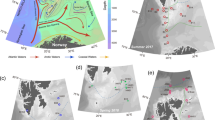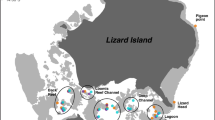Abstract
Insular marine biotas are often richer in faunal diversity than those from the open sea in the same geographical region. The existence of particular island effects were tested under polar conditions by comparing infaunal benthic assemblages on Peter I Island with those of similar latitudes in the open ocean at the Bellingshausen Sea and also from the coast of the Antarctic Peninsula. Sampling was carried out aboard the R/V Hespérides during the expedition named BENTART-2003 from 24 January to 3 March 2003. Benthic samples were collected at 18 stations ranging from 90 to 2 044 m depth, using an USNEL-type box corer (BC) dredge. Representatives of 32 higher taxa of invertebrates were found. Univariate and multivariate analyses revealed various patterns in the data. First, significant differences in polychaete abundance were detected between the stations located in the open sea and the remaining sites (island plus mainland sites). Bivalve abundances were also distinct between island and mainland sampling sites. Sediment columns taken from the island seafloor exhibited the highest rate of bioturbation by the infauna. These findings confirm the model that islands develop distinct assemblages characterized by the enhancement of the benthic communities even in cold waters. Several abiotic factors were measured simultaneously at the seafloor and along the water column to investigate faunal distribution patterns. Significant correlations were found between the benthic assemblages and a combination of two environmental variables: “island effect” (measured as a categorical variable) and the redox state of sediments. Richer andmore complex benthic assemblages were found in Peter I Island’s sea bottom, whereas the more depauperate bottoms remained in the open sea.
Similar content being viewed by others
References
Ameneiro J, Mouriño-Carballido B, Parapar J, et al. 2012. Abundance and distribution of invertebrate larvae in the Bellingshausen Sea (West Antarctica). Polar Biol, 35: 1359–1373
Arnaud P M. 1974. Contributions to the marine benthic bionomy from antarctic and subantarctic regions. Téthys (in French), 6: 465–656
Arntz W E. 2006. Bouvet Island: a stepping stone in the Southern Ocean?. Polar Biol, 29: 81–82
Arntz W E, Thatje S, Linse K, et al. 2006. Missing link in the Southern Ocean: sampling the marine benthic fauna of remote Bouvet Island. Polar Biol, 29: 83–96
Aronson R B, Thatje S, Clarke A, et al. 2007. Climate Change and Invasibility of the Antarctic Benthos. Annu Rev Ecol Evol Syst, 38: 129–154
Barnes D K A. 2008. A benthic richness hotspot in the Southern Ocean: slope and shelf cryptic benthos of Shag Rocks. Antarctic Science, 20(3): 263–270
Beckley L E, Branch G M. 1992. A quantitative scuba-diving survey of the sublittoral macrobenthos at subantarctic Marion Island. Polar Biol, 11: 553–563
Benedetti-Cecchi L, Maggi E, Bertocci I, et al. 2003. Variation in rocky shore assemblages in the northwestern Mediterranean: contrasts between islands and the mainland. Journal of Experimental Marine Biology and Ecology, 293: 193–215
Branch G M, Attwood C G, Gianakouras D, et al. 1993. Patterns in the benthic communities on the shelf of the sub-Antarctic Prince Edward Islands. Polar Biol, 13: 23–34
Carr M H, Neigel J E, Estes J A, et al. 2003. Comparing marine and terrestrial ecosystems: implications for the design of coastal marine reserves. Ecological Applications, 13(Supp): 90–107
Cartes J E, Maynou F, Moranta J, et al. 2004. Patterns of bathymetric distribution among deep-sea fauna at local spatial scale: comparison of mainland vs. insular areas. Progress in Oceanography, 60: 29–45
Clarke A. 1990. Temperature and evolution: Southern Ocean cooling and the Antarctic marine fauna. In: Kerry K R, Hempel G, eds. Antarctic Ecosystems. Ecological Change and Conservation. Berlin: Springer-Verlag, 9–22
Clarke A, Johnston N M. 2003. Antarctic Marine Benthic diversity. Oceanography and Marine Biology: an Annual Review, 41: 47–114
Clarke K R, Gorley R N. 2006. PRIMER (Plymouth Routines In Multivariate Ecological Research) v6: User manual/tutorial. Plymouth, UK: PRIMER-E Ltd, 1–190
Cosson-Sarradin N, Sibuet M, Paterson G L J, et al. 1998. Polychaete diversity at tropical Atlantic deep-sea sites: environmental effects. Mar Ecol Prog Ser, 165: 173–185
Dando P R, Southward A J, Southward E C. 2004. Rates of sediment sulphide oxidation by the bivalve mollusc Thyasira sarsi. Mar Ecol Prog Ser, 280: 181–187
Dufour S C. 2005. Gill anatomy and the evolution of symbiosis in the bivalve family Thyasiridae. Biol Bull, 208: 200–212
Dufour S C, White C, Desrosiers G, et al. 2008. Structure and composition of the consolidatedmud tube of Maldane sarsi (Polychaeta: Maldanidae). Estuarine, Coastal and Shelf Science, 78: 360–368
Eleftheriou A, McIntyre A. 2005. Methods for the Study of Marine Benthos. Oxford: Blackwell
Fauchald K, Jumars P. 1979. The diet of worms: a study of polychaete feeding guilds. Oceanography and Marine Biology: An Annual Review, 17: 193–284
García-Raso J E, Manjón M E, Ramos A, et al. 2005. New record of Lithodidae (Crustacea Decapoda, Anomura) from the Antarctic. Polar Biol, 28: 642–646
González J A, Montes C, Rodríguez J, et al. 2008. Rethinking the Galapagos Islands as a complex social-ecological system: implications for conservation and management. Ecology and Society, 13(2): 13
Gutt J. 2006. Mega-epibenthos at Bouvet Island (South Atlantic): a spatially isolated biodiversity hot spot on a tiny geological spot. Polar Biol, 29: 97–105
Jaramillo E, López J, Incera M, et al. 2008. Sedimentary characteristics, macroinfauna and types and abundances of bivalves in a tidal flat of the Nord-Patagonic Archipelago, Chile. Vie et Milieu-Life and Environment, 58: 11–23
Kaiser S, Barnes D K A, Linse K, et al. 2008. Epibenthic macrofauna associated with the shelf and slope of a young and isolated Southern Ocean island. Antarctic Science, 20(3): 281–290
Kier G, Kreft H, Lee TM, et al. 2009. A global assessment of endemism and species richness across island and mainland regions. PNAS, 106: 9322–9327
Kimura K. 1982. Geological and geophysical survey in the Bellingshausen Basin, off Antarctica. Antarct Rec, 75: 12–24
Klages M, Gutt J, Starmans A, et al. 1995. Stone crabs close to the Antarctic continent: Lithodes murrayi Henderson 1888 (Crustacea, Decapoda, Anomura) off Peter I Island (68°51′S, 90°51′W). Polar Biol, 15: 73–75
Knox G A. 1994. The biology of the Southern Ocean. Cambridge: Cambridge University Press
Kröncke I, Vanreusel A, Vincx M, et al. 2000. Different benthic size compartments and their relation to sediment chemistry in the deep Eurasian Arctic Ocean. Mar Ecol Prog Ser, 199: 31–41
Levin L, Blair N, DeMaster D, et al. 1997. Rapid subduction of organic matter by maldanid polychaetes on the North Carolina slope. Journal of Marine Research, 55: 595–611
Linse K. 1999. Abundance and diversity of Mollusca in the Beagle Channel. Scientia Marina, 63(Supp 1): 391–397
Linse K. 2006. New records of shelled marine molluscs at Bouvet Island and preliminary assessment of their biogeographic affinities. Polar Biol, 29: 120–127
López E, Parapar J, Laborda A, et al. 2005. Biodiversity and distribution patterns of soft bottom polychaetes from South Shetland Islands to Bellingshausen Sea. Preliminary results of BENTART-2003. Berichte zur Polar- und Meeresforschung, 507: 158–159
MacArthur R H, Wilson E O. 1967. The Theory of Island Biogeography. Princeton: Princeton University Press
Myers A A. 1997. Biogeographic barriers and the development of marine biodiversity. Estuarine and Coastal Shelf Science, 44: 241–248
Nicol D. 1967. Some characteristics of cold-water marine pelecypods. Journal of Paleontology, 41: 1330–1340
Pakhomov E A, Froneman P W. 1999. The Prince Edward Islands pelagic ecosystem, south Indian Ocean: a review of achievements, 1976–1990. Journal of Marine Systems, 18: 355–367
Parapar J, López E, Gambi M C, et al. 2011. Quantitative analysis of soft-bottom polychaetes of the Bellingshausen Sea and Gerlache Strait (Antarctica). Polar Biol, 34: 715–730
Pearson T H, Mannvik H P, Evans R, et al. 1996. The benthic communities of the Snorre Field in the northern North Sea (61°30′N 2°10′E): 1. The distribution and structure of communities in undisturbed sediments. Journal of Sea Research, 35: 301–314
Piepenburg D, Schmid M K, Gerdes D. 2002. The benthos off King George Island (South Shetland Islands, Antarctica): further evidence for a lack of latitudinal biomass cline in the Southern Ocean. Polar Biol, 25: 146–158
Rosenberg R, Nilsson H C, Diaz R J. 2001. Response of Benthic Fauna and Changing Sediment Redox Profiles over a Hypoxic Gradient. Estuarine, Coastal and Shelf Science, 53: 343–350
Saiz J I, García F J, Manjón M E, et al. 2008. Community structure and spatial distribution of the macrofauna at the Bellingshausen Sea (West Antarctica). Polar Biol, 31: 735–743
Schiaparelli S, Lörz A N, Cattaneo-Vietti R. 2006. Diversity and distribution of mollusc assemblages on the Victoria Land coast and the Balleny Islands, Ross Sea, Antarctica. Antarctic Science, 18(4): 615–631
Smith C R, Hessler R R. 1987. Colonization and succession in deep-sea ecosystems. Trends in Ecology and Evolution, 2: 359–363
Soto E H, Paterson G L J, Billet D S M, et al. 2010. Temporal variability in polychaete assemblages of the abyssal NE Atlantic Ocean. Deep-Sea Research Part II: Topical Studies in Oceanography, 57: 1396–1405
Troncoso J S, Aldea C, Arnaud P, et al. 2008. Quantitative analysis of soft-bottom molluscs in the Bellingshausen Sea and around Peter I Island. Polar Research, 26: 126–134
Vincent A, Clarke A. 1995. Diversity in the marine environment. Trends in Ecology and Evolution, 10: 55–56
Whittaker R J, Fernández-Palacios J M. 2007. Biogeography: Ecology, Evolution, and Conservation. Oxford: Oxford University Press
Author information
Authors and Affiliations
Corresponding author
Additional information
Foundation item: The “BENTART-03” cruise was funded by the Antarctic Program REN2001-1074/ANT of the Spanish Government. The completion of the manuscript was aided by a grant “Acción Especial” from the University of Basque Country/EHU (Spain).
Rights and permissions
About this article
Cite this article
Saiz, J.I., Anadón, N., Cristobo, J. et al. Enhancement of the benthic communities around an isolated island in the Antarctic Ocean. Acta Oceanol. Sin. 32, 47–55 (2013). https://doi.org/10.1007/s13131-013-0321-5
Received:
Accepted:
Published:
Issue Date:
DOI: https://doi.org/10.1007/s13131-013-0321-5




